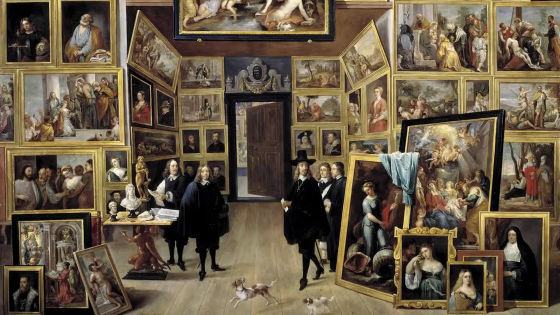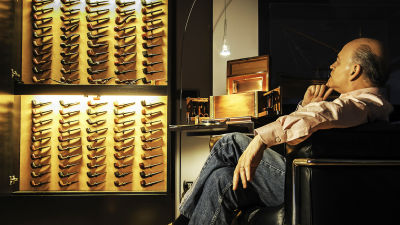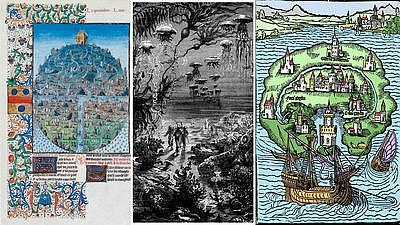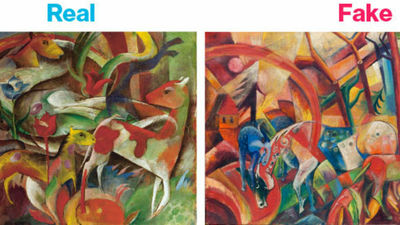'The Case for Museums' explains in a movie why museums and art galleries exist in the first place

Many people visit art galleries and museums, which are packed with expensive art pieces and historically valuable objects, with the purpose of 'seeing beautiful things.' However, according to The Art Assignment, which produces videos about history and art, museums such as art galleries and museums have a more important purpose than 'beauty,' and therefore people should visit museums multiple times.
For hundreds of years, people have stored historical objects, valuable metals, art, and other things they consider 'valuable' in secure buildings.

Museums such as art galleries and museums are prime examples of this.

This work has been carried out mainly by the privileged classes who hold power.

However, many powerful people throughout history simply stored the things they owned or stole in buildings, and did not make them accessible to the general public.

As of 2018, many cities have at least one 'building dedicated to storing and displaying precious objects.'

Why do we need museums and art galleries, and why should we visit them again and again? To answer this question, we need to understand the history of art museums and the role they play.

The word 'museum' comes from the ancient Greek goddess

The museum that existed in

Also, museums in ancient Rome were places for philosophical discussions.

Today, museums display art and artifacts, but in ancient times, paintings glorifying the gods were displayed on

On the other hand, wealthy people sometimes decorated their homes with art, just like wealthy people do today.

During the Renaissance,

And the Medici eventually treated these works of art as public property.

The first national museums were established in Europe in the 18th century.

Wealthy people donated their collections with the intention that they would be preserved and shared with the public after their deaths.

And then the French Revolution happened in 1789...

A collection that once belonged to members of the royal family is now open to the public.

Collecting art, whether it be war memorabilia or artwork created by artists, is extremely difficult because the works are often separated from their context, such as their creators or the communities in which they were born.

Determining the origins and history of an object is a difficult task that sometimes leads to litigation.

Looted items are often returned to their owners decades or even centuries later.

However, museums not only 'store' their collections but also 'make them public,' allowing people to enjoy and learn about historical objects, which also helps 'to find and return them to their original owners.'

And how we display our collections has also changed over the years.

The practice of cramming cabinets and walls with stuffed animals and rare collections was adopted in Europe in the 16th and 17th centuries.

The salon style of paintings covering the walls from floor to ceiling was adopted by the Louvre Museum in the 19th century.

Nowadays, exhibitions are held in

Technology has also revolutionized the way people learn from collections.

Similarly, the shapes of buildings have changed. Starting with pyramids...

Classical Building



What if there was a facility with a modern cube building next to a classical building?

There are also museums with unique shapes.


However, all museums have the same goal: to allow people today to experience valuable objects that were created and used before the modern era.

The objects in the museum give us clues about where they were made, when they were made, and who made them.

It also explains the history of the objects, not just the 'conditions in which they were made,' but also how they have been sold, changed hands, entered collections, and when they have or have not been on public display.

The objects visualize the changing values of the past, present, and future, and by repeatedly visiting the museum, we can revisit history and revive the voices and stories of the oppressed that have been drowned out by history.

Museum contents may be displayed in various combinations, or may remain in the same combination for years.

This kind of 'combination' helps people understand that history is not 'a single line stretching backwards,' but rather that it is made up of multiple intertwining threads.



Museums are heavily influenced by who leads them and which foundations support them, which can lead to reckless decisions about staff salaries and fees.

However, these decisions are made in order to fulfill our mission of keeping the object open to the public at all times.

Even in emergencies like wildfires and rising sea levels...

These staff members are able to implement the predetermined plan.

In addition, restoration managers will work to ensure that historical objects continue to be preserved in an appropriate form ...

The collection is protected by trained guards.

Packing, moving and displaying collections also requires expertise.

Talk about history through the exhibits ...

Research into collections sheds light on the past, predicts the future, and generates benefits for society. Many of the staff involved in museum operations are educated and trained professionals.

In recent years, volunteers have been working to make it possible for people to view the collection without visiting the museum.

It's important to make it clear that museums are not 'entertainment that you can sit back and enjoy.'

The true value of a museum is not to 'overwhelm people with beauty,' but to 'make visitors reconsider history, understand where we are now, and how we can change the future.'

If we don't just look at what's on display, but stop to think with curiosity and patience, museums will turn into something like universities or libraries.

This is why you should visit museums multiple times. People change over the years, so by visiting multiple times, you will gain different insights.

Related Posts:







